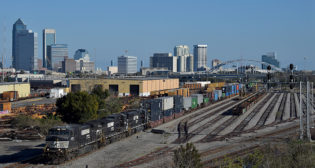
UPDATED: NYCT President Byford Resigns
Written by Andrew CorselliOn Jan. 23, following two years of service that saw major improvements to New York City’s 116-year-old rapid transit system, MTA New York City Transit President Andy Byford resigned.
Even though the New York Metropolitan Transportation Authority did not give a reason for the resignation, its is now widely known that Byford was fed up with political meddling perpetrated by New York Gov. Andrew Cuomo. As well, Byford was unwilling to work within the constraints of the MTA’s Cuomo-ordered “Transformation Plan,” which would have diminished his role to running day-to-day NYCT operations. In those respects, Byford’s departure was not unexpected. His last day of service will be Friday, Feb. 21.
In his resignation letter to MTA Chief Operating Officer Mario Peloquin, Byford referred to the Alix Partners plan as “calling for the centralization of projects and an expanded headquarters, leaving agency Presidents to focus solely on the day-to-day running of service.” This was not what Byford was hired to do:
“Andy Byford will be departing New York City Transit after a successful two years of service, and we thank him for his work,” said MTA Chairman and CEO Patrick J. Foye. “Andy was instrumental in moving the system forward, enacting the successful Subway Action Plan, and securing record capital funding with the Governor and the Legislature, and we wish him well in his next chapter.”
“I’m very proud of what we have achieved as a team over the past two years and I believe New York City Transit is well-placed to continue its forward progress now that the MTA has a record-breaking $51.5 billion Capital Program in place,” said Byford. “I’m very grateful to Governor [Andrew] Cuomo, Chairman Foye and members of the Board for giving me the opportunity to serve New York and to head up North America’s largest transit system.”
Cuomo dismissed claims that disagreements with him led Byford to resign, “indicating that plans to reorganize the transit agency—and take some responsibilities away from Byford—might have contributed to his decision, The New York Times reported on Jan. 23. “He did the job for two years,” Cuomo told reporters. “Nobody does these jobs for a lifetime.”
Byford, according to The Times, had considered resigning as early as last spring as he struggled to get along with Cuomo, who controls MTA funding and has taken charge of key appointments such as the MTA chairmanship. Cuomo was “angry” after Byford tried to resign in October, according to MTA officials who spoke with The Times on the condition of anonymity to discuss personnel issues. Byford’s superiors convinced him to stay, “but the détente did not last long.” Cuomo then told state officials that his relationship with Byford had reached its end point, and that he expected Byford to resign by first-quarter of 2020.
By December, Byford “made up his mind that he would leave after completing his second year, those officials said,” The Times noted. “Another likely departure, the officials said, is Pete Tomlin, who was brought in by Byford to run a multibillion dollar overhaul of the signal system (accelerating rollout of CBTC), considered the linchpin of efforts to transform the subway.”
Sure enough, Tomlin resigned on Jan. 24.
In a phone interview with The Times, Byford said he was not pressured to resign. “This was 100% my decision,” he said. “There was no external pressure for me to go. This is something I’ve given careful thought to.”
Byford came to NYCT from the Toronto Transit Commission in January 2018 after Cuomo had declared the subway to be in a state of emergency. “His sweeping plans and dogged work ethic made New Yorkers rally around him,” The Times said. “Byford’s arrival … was celebrated as a turning point for the subway, and profiles in The New Yorker and on 60 Minutes followed.
“When Byford took over running the subway, only 58% of trains were on time. There were near-constant meltdowns and several train derailments raised safety concerns. Byford helped push the on-time rate more than 80% through a series of operational changes and a focus on the basics, including repairing faulty switches and increasing train speeds. He said he wanted to bring the on-time rate into the 90s and proposed a major overhaul of the subway’s ancient signal equipment.
“Byford had developed a cult following among transit enthusiasts, who plastered stickers with his face on street posts with the slogan: ‘Train Daddy Loves You Very Much.’ He could often be found greeting riders at stations with a huge smile and he focused attention on the needs of disabled New Yorkers. He even once grabbed a broom to help clean a flooded station.”
MTA officials now face the difficult task of replacing Byford and Tomlin. A top contender for Byford’s job could be NYCT Senior Vice President Subways Sally Librera, the first woman in her post.
“Subway and bus riders are grateful to Andy Byford for his historic service at New York City Transit,” said Riders Alliance Executive Director John Raskin. “In two years, Andy made subways faster and more reliable, he tackled longstanding challenges to improving bus service, and he crafted the first plan in a generation that would truly modernize the transit system.
“No matter who runs the transit system day-to-day, ultimately Governor Cuomo is in charge of the MTA, and riders will be holding the governor accountable for the quality of our transit service. With whatever management team he puts in place, the governor is on the hook for making subways faster and more reliable, rescuing buses from years of decline, and delivering on a $51 billion capital program to fix public transit for the long term.”


![[Photo by Christopher Rosario U.S. Army Corps of Engineers, Baltimore District]](https://www.railwayage.com/wp-content/uploads/2024/05/dalibowcrush-315x168.jpg)
